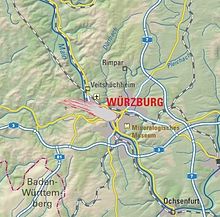Meteorite Fall Würzburg (1103/1104)
| Meteorite Fall Würzburg (1103/1104) | |
|---|---|
| place | Wurzburg |
| Locality | Schottenkloster St. Jakob |
| Fall time | 12th or 13th century |
| authenticity | implausible |

The Würzburg meteorite fall is an alleged fall of a meteorite on the tower of the Schottenkloster St. Jakob in Würzburg in the year 1103 or 1104. There are many inconsistencies in the documentation of the case, so that the authenticity is rather lacking, especially since the monastery only 30 years later was built.
Case reports
The geologist Carl Wilhelm Gümbel wrote in 1878 that the stone had disappeared. In order to “investigate the traces of this stone, he turned to Prof. Sandberger in Würzburg, who was kind enough to do the most thorough research”. He owes the news to him that the physician Friedrich Schnurrer (1784–1833) wrote in the second volume of his epidemic history: “In 1103 (or 1104) a meteor stone fell in Würzburg so large that four men hardly carry the fourth part of it could. ”Schnurrer refers to various chronicles as well as to the abbot of the Schottenkloster, Johannes Trithemius , who believed this news completely.
Inconsistencies
The reports of the Würzburg meteorite fall are unclear and contradictory.
Würzburg hailstone
The case of large "hailstones" in Würzburggau ( pagus Wirciburgensis ) is described in several chronicles with almost the same wording, but in the chronicles of Ekkehard von Aura (around 1120), Annalista Saxo (around 1150), Burchard von Ursberg (after 1200 ) and the Annales Hirsaugienses of the abbot Trithemius (1509–1514) put in the year 1104, in the world chronicle of Johannes Nauclerus (1516) in the year 1103.
Würzburg tower collapse
The tower of the Schottenkloster St. Jakob in Würzburg is said to have collapsed in the 12th century . One knew of an Irish traveling bishop named Kilian , who worked in Würzburg in the 7th century. From then on, Würzburg was a destination for pilgrims . The Irish were then called Scots . The monastery was founded by the Würzburg bishop Embricho and St. Makarius (1100–1153). The monastery was built between 1134 and 1139. Soon afterwards the tower of the Schottenkloster collapsed - probably around 1146, when Makarius was on a trip to Rome, because legend has it that Makarius saw the collapse from Rome.
Würzburg thunderbolt
The Würzburg scholar Caspar Schott reported in 1667 in the second volume of his Physica curiosa that in Würzburg a lapis fulmineus (a "lightning stone" or "thunderbolt") was hanging on a chain on a column in the church of the Schottenkloster St. Jacob . The people say the stone is a lightning bolt. The meteorite researcher Chladni increased the confusion. He mixed up the information about the thunderbolt with the information about the meteor: At the time of St. Makarius in the 13th century (sic!) A stone fell on the tower of the monastery. According to Schott, the stone had previously been kept hanging on a chain in the church of the monastery and is now in the natural history cabinet of the university. He saw the stone himself; it is a battle ax "made of a very hard, gray type of stone that bears no resemblance to meteor stones, so the correctness of this event itself must be doubted."
Further contradictions
Chladni describes a battle ax. According to Schnurrer's statements, "such a large hail fell at Würzburg, a meteor stone fall, that a hailstone was divided into four pieces and four men were hardly able to carry one". While four men with Schnurrer could hardly carry a "hailstone", in the secondary quote with Gümbel, who only knew Schnurrer's work from a letter communicated, there were already 16 men.
literature
- Bavarian State Office for the Environment : Out of this world. Bavaria's meteorite. Self-published, Augsburg 2012, ISBN 978-3-936385-92-2
Individual evidence
- ↑ a b Carl Wilhelm Gümbel : About the stone meteorites found in Bavaria . In: Meeting reports of the Mathematical-Physical Class of the KB Academy of Sciences in Munich, Munich 1878, pp. 14–72, here p. 16
- ↑ Werner E. Gerabek : Schnurrer, Friedrich. In: Werner E. Gerabek, Bernhard D. Haage, Gundolf Keil , Wolfgang Wegner (eds.): Enzyklopädie Medizingeschichte. De Gruyter, Berlin / New York 2005, ISBN 3-11-015714-4 , pp. 1304 f.
- ↑ a b Friedrich Schnurrer : The diseases of the human race , part 1: Chronicle of epidemics , part 1, Osiander, Tübingen 1823, p. 229. Online
- ↑ Georg Heinrich Pertz u. a. (Ed.): Scriptores (in Folio) 6: Chronica et annales aevi Salici. Hannover 1844, p. 226 ( Monumenta Germaniae Historica , digitized version ), lines 25-27
- ↑ Klaus Naß (Ed.): Scriptores (in Folio) 37: Die Reichschronik des Annalista Saxo. Hannover 2006, p. 513 ( Monumenta Germaniae Historica , digitized version ), lines 11-13
- ↑ Burchard von Ursberg : Chronicon Abbatis Urspergensis a Nino ... usque ad Fridericum II. , Augsburg 1515, unpaginated, lines 7–12, image 208 of the digitized version. On-line
- ↑ Johannes Trithemius : Annales Hirsaugienses , St. Gallen 1690, p. 330, lines 10-15. On-line
- ↑ Johannes Nauclerus : Memorabilivm Omnis Aetatis Et Omnivm Gentivm Chronici Commentarii , Tübingen 1516, fol. 170 v , lines 12–15, image 774 of the digitized version. On-line
- ^ Bavarian State Office for the Environment: Not of this world. Bavaria's meteorite. Self-published, Augsburg 2012, pp. 20–21
- ↑ Caspar Schott : Physica curiosa ... , Volume 2, Würzburg 1667, Lib. XI, cap. XIX, De Lapide fulmineo , p. 1238. Online
- ↑ Ernst Florens Friedrich Chladni : About the fire meteors and the masses that fell with them . Heubner, Vienna 1819, p. 199 f. On-line
